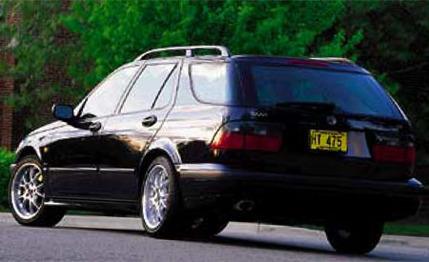 Short Take Road Test
Short Take Road Test
First let's clear up any confusion over the names of Saab's latest generation of cars. A Saab spokesman assured us that the cryptic 9-3 and 9-5 designations are not the company's office hours but an homage to the past-the number 9 is deeply rooted in Saab's history. Long before the Beatles made it a mantra in "Revolution 9," Saab, which began as an aircraft manufacturer in the '30s, used "9" as the first digit of its airplane labels and carried the practice over to its automobiles. Saab's first car, in 1949, was tagged 92, and the numbering system continued through the 90, 900, and 9000 series. As for the -3 and -5, they refer to the generations of Saab cars over all those years.
As for Aero, we thought it might have something to do with aerodynamics. Wrong. Despite the wagon's low drag coefficient of 0.31, the term is more hat tipping to Saab's aviation roots. The first Aero models-sportier versions of 900-and 9000-series cars-appeared in 1984.Today the company is highlighting its air-craft connection by calling one model Viggen, the name of a Saab jet fighter, and using said aircraft in commercials for the Aero series.
The irony here is that Saab, which is an acronym for Svenska Aeroplan Aktiebolaget, is no longer in the aircraft business. At least not Saab the automaker, which is a wholly owned subsidiary of General Motors. As such, we wondered, how much of Saab's actual heritage has seeped into its current cars?
Over the years, Saab has appealed to enthusiasts with its eccentric styling, surprising performance, and lovable sort of quirkiness that set it apart from the general run of cars. Much of that is gone now, which isn't all that bad. Nostalgia is not a very productive engineering criterion.
Still, there's much Saabishness about the Aero wagon. Its styling is traditionally low-key although its grille leaves no doubt about its identity. And the love-it-or-hate-it ignition switch is still on the floor between the front seats. More important, its all-around performance and generally solid, well-made feel do justice to Saab's rally-winning tradition.
In our March '99 test of a 9-5 wagon, we said it "may be the best-handling Saab ever built." The Aero variation is even more so. Its ride height is reduced by nearly half an inch, and the front and rear anti-roll bars are stiffer, as are the springs and dampers. The front and rear suspension bushings have been beefed up and the MacPherson struts retuned with new pistons. The front brake discs are larger, and the wagon's standard tires are grippy Michelin Pilot HX 225/45WR-17s.
On the appearance side, the Aero wagon is distinguished by flared rocker panels, a front air dam, and a rear valance. The wheels are alloy 10-spoke, two-piece BBSs. A sportier steering wheel with polished wood grips adds a luxo touch.
The biggest difference between the standard Saab station wagon and the Aero version is 60 horsepower. This Aero wagon's four-cylinder engine puts out 230 horsepower, and its boost is quite apparent, especially with a manual transmission (the automatic we tested is optional). The Aero inhales first gear so quickly that it takes a little practice to stay out of the rev limiter before snapping the smooth-shifting, short-throw lever through the gears. There's a noticeable tug of torque steer off the line with the manual, but this disappears with the automatic. Acceleration through the gears is more like a sports car's than a sports wagon's, and throttle response is impressive across the normal driving speed range. Seldom is a quick downshift required for passing, but when it's needed, the power is right there.
The suspension tweaks and chassis changes in the Aero are also readily obvious. Its steering is light but communicative. In quick transitions there's little apparent body roll, and on high-speed sweepers the car takes a solid set and tracks around without a twitch. At lower speeds on twisty roads, the car is agile and responsive. We weren't able to test the Aero wagon on the skidpad, but we expect the wagon to corner about as hard as the sedan, which generates 0.86 g on the circle.
The wagon's seats are firm and comfortable, and its controls, instruments, and interior fittings are well designed and intuitive to use. Among the useful options is a sliding rear cargo floor that rolls out beyond the sill and will handle a load of nearly 300 pounds, which makes stowing a lot easier and also provides a tailgate.
At a base price of $43,192, compared with the standard wagon's $33,695, the Aero extracts a toll for its virtues. But even at that steep tariff, it slots in quite comfortably among its few competitors in the luxo-sports-wagon niche.